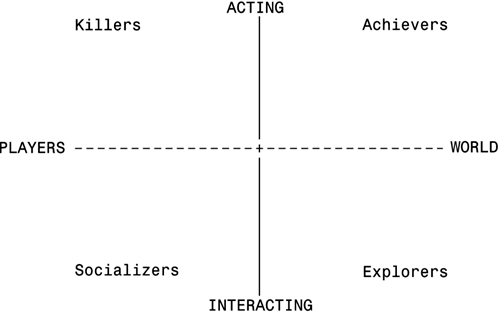| Consider the abstract graph shown in Figure D.1. Figure D.1. Interest graph.  The axes of the graph represent the source of players' interest in a MUD. The X-axis goes from an emphasis on players (left) to an emphasis on the environment (right); the Y-axis goes from acting with (bottom) to acting on (top). The four extreme corners of the graph show the four typical playing preferences associated with each quadrant. To see how the graph works, it is appropriate to consider each of the four styles in detail: -
Achievers are interested in doing things to the game, i.e., in ACTING on the WORLD. It's the fact that the game environment is a fully-fledged world in which they can immerse themselves that they find compelling; its being shared with other people merely adds a little authenticity and perhaps a competitive element. The point of playing is to master the game and make it do what you want it to do; there's nothing intrinsically worthwhile in rooting out irrelevant details that will never be of use or in idling away your life with gossip. Achievers are proud of their formal status in the game's built-in level hierarchy and of how short a time they took to reach it. -
Explorers are interested in having the game surprise them, i.e., in INTERACTING with the WORLD. It's the sense of wonder that the virtual world imbues that they crave for; other players add depth to the game, but they aren't essential components of it, except perhaps as sources of new areas to visit. Scoring points all the time is a worthless occupation because it defies the very open -endedness that makes a world live and breathe. Most accomplished explorers could easily rack up sufficient points to reach the top, but such one-dimensional behavior is the sign of a limited intellect. Explorers are proud of their knowledge of the game's finer points, especially if new players treat them as founts of all knowledge. -
Socializers are interested in INTERACTING with other PLAYERS. This usually means talking, but it can extend to more exotic behavior. Finding out about people and getting to know them is far more worthy than treating them as fodder to be bossed around. The game world is just a setting; it's the characters that make it so compelling. Socializers are proud of their friendships, their contacts, and their influence. -
Killers are interested in doing things to people, i.e., in ACTING on other PLAYERS. Normally, this is not with the consent of these "other players" (even if, objectively, the interference in their play might appear "helpful"), but killers don't care; they wish only to demonstrate their superiority over fellow humans , preferably in a world that serves to legitimize actions that could mean imprisonment in real life. Accumulated knowledge is useless unless it can be applied; even when it is applied, there's no fun unless it can affect a real person instead of an emotionless, computerized entity. Killers are proud of their reputation and of their oft-practiced fighting skills. The "interest graph" is a representational structure that can chart what players find of interest in a MUD. The axes can be assigned a relative scale reflecting the ratio of an individual's interest between the two extremes that it admits. Thus, for example, someone who thinks that the people who are in the world are maybe twice as important as the world itself would lie on a vertical line intersecting the X-axis at a point 1/6 of the distance from the origin to the left edge; if they had little interest in bending the game to their will, preferring their actions to have some give and take, then they would also lie on a horizontal line at the bottom of the Y-axis. The intersection of the two lines would put them in the socializer quadrant, with leanings to explorer. It is, of course, possible to analyze the behavior of individual players quantitatively by processing transcripts of their games . Unfortunately, this is very difficult to do except for very limited domains (e.g., forms of communication [Cherny, 1995a; Cherny, 1995b]). An alternative approach might simply be to ask the players what they themselves like about a particular MUD; even a short questionnaire, completed anonymously, can give a fair indication of what players find enjoyable (Emert, 1993). Such information can then be used to determine the make-up of the MUD's player base, so that in times of falling player numbers the current composition could be compared against some earlier ideal, and remedial action taken to redress the imbalance. This "ideal" configuration would, however, be specific to that particular MUD, and its precise form is therefore not addressed here. Instead, the more general issue of how to alter the balance between player types is considered , along with the gross effects that can be expected to follow from having done so.  |
